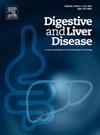Liver transplantation following HCC rupture and long-term immunotherapy: a case report
IF 3.8
3区 医学
Q1 GASTROENTEROLOGY & HEPATOLOGY
引用次数: 0
Abstract
Introduction Liver transplantation (LT) provides a curative option for patients with cirrhosis and early-stage hepatocellular carcinoma (HCC). Recently, the use of immune checkpoint inhibitors (ICIs) has broadened treatment options for advanced HCC. Their role in downstaging and bridging to LT, especially in cases complicated by tumor rupture, is still under investigation. Herein, we report a case of a man with advanced HCC who underwent a successful LT after a prolonged treatment with ICIs. Case ReportA 54-year-old Caucasian male was admitted to a Spanish Hospital in June 2019 due to hypovolemic shock secondary to hemoperitoneum. A CT scan showed multifocal lesions within the liver (the majors being 8 cm in diameter at the VIIIs and 4 cm at the IIIs) with radiological features consistent with advanced HCC without biliary or vascular invasion; intraperitoneal bleeding was due to rupture of a nodule. AFP level was 219.8 ng/ml. The patient was then transferred to Our Center with a diagnosis of multifocal HCC in HCV-positive cirrhosis (see figure 1), with a preserved liver function (Child-Pugh A5). The patient underwent percutaneous intralesional injections of Pexa-Vec (3 injections) in the largest nodule and was started on Nivolumab 240 mg IV every 14 days. Both treatments were well tolerated, and no significant complications were recorded. HCV infection was treated using a direct-acting antiviral (sofosbuvir/velpatasvir), with SVR. The patient received a total of 93 ICIs infusions by May 2023. CT, MRI, and PET scans were then performed, which did not show the presence of active disease or portal vein thrombosis (see Figure 1). AFP levels were within the normal range. Considering the complete oncological response, the patient was subsequently screened for an LT, which was performed in September 2023, approximately 12 weeks after discontinuation of Nivolumab. As for July 2025, 21 months after LT, the patient is doing well; he has not experienced any episode of acute cellular rejection, and no radiological signs of HCC recurrence have been recorded. ConclusionsThis is the first case report on a successful LT performed after prolonged ICIs treatment for an advanced HCC with spontaneous intraperitoneal rupture. The positive outcome of LT challenges conventional concerns regarding peritoneal seeding and recurrence risks in ruptured HCC. Moreover, the case supports the emerging role of ICIs in managing advanced HCC, potentially extending transplant eligibility for carefully selected patients. Further research is ongoing to establish guidelines for integrating these therapies into long-term treatment LT protocols.
肝细胞癌破裂后肝移植及长期免疫治疗1例报告
肝移植为肝硬化和早期肝细胞癌(HCC)患者提供了一种治疗选择。最近,免疫检查点抑制剂(ICIs)的使用扩大了晚期HCC的治疗选择。它们在降低分期和桥接到LT中的作用,特别是在合并肿瘤破裂的情况下,仍在研究中。在此,我们报告一例晚期HCC患者在长期使用ICIs治疗后成功进行了肝移植。病例报告:2019年6月,一名54岁白人男性因腹膜出血继发低血容量性休克入院。CT扫描显示肝脏内多灶性病变(主要为8厘米直径的viii和4厘米直径的iii),影像学特征与晚期HCC一致,未侵犯胆道或血管;腹腔内出血是由于结节破裂所致。AFP水平为219.8 ng/ml。随后,患者被转移到我们的中心,诊断为hcv阳性肝硬化的多灶性HCC(见图1),肝功能保存(Child-Pugh A5)。患者在最大的结节处经皮注射Pexa-Vec(3次注射),并开始每14天服用Nivolumab 240mg IV。两种治疗均耐受良好,无明显并发症记录。HCV感染使用直接作用抗病毒药物(sofosbuvir/velpatasvir)治疗,具有SVR。截至2023年5月,患者共接受了93次ICIs输注。然后进行CT, MRI和PET扫描,未显示活动性疾病或门静脉血栓的存在(见图1)。甲胎蛋白水平在正常范围内。考虑到完全的肿瘤反应,患者随后接受了LT筛查,该筛查于2023年9月进行,约在Nivolumab停药后12周。截至2025年7月,术后21个月,患者恢复良好;他没有经历任何急性细胞排斥反应,也没有HCC复发的影像学征象记录。结论:这是第一例晚期肝癌自发性腹膜内破裂患者经延长ICIs治疗后成功行肝移植的病例报告。肝移植的积极结果挑战了关于腹膜播种和破裂HCC复发风险的传统担忧。此外,该病例支持了ICIs在晚期HCC治疗中的新兴作用,可能会延长精心挑选的患者的移植资格。目前正在进行进一步的研究,以建立将这些疗法纳入长期治疗LT方案的指南。
本文章由计算机程序翻译,如有差异,请以英文原文为准。
求助全文
约1分钟内获得全文
求助全文
来源期刊

Digestive and Liver Disease
医学-胃肠肝病学
CiteScore
6.10
自引率
2.20%
发文量
632
审稿时长
19 days
期刊介绍:
Digestive and Liver Disease is an international journal of Gastroenterology and Hepatology. It is the official journal of Italian Association for the Study of the Liver (AISF); Italian Association for the Study of the Pancreas (AISP); Italian Association for Digestive Endoscopy (SIED); Italian Association for Hospital Gastroenterologists and Digestive Endoscopists (AIGO); Italian Society of Gastroenterology (SIGE); Italian Society of Pediatric Gastroenterology and Hepatology (SIGENP) and Italian Group for the Study of Inflammatory Bowel Disease (IG-IBD).
Digestive and Liver Disease publishes papers on basic and clinical research in the field of gastroenterology and hepatology.
Contributions consist of:
Original Papers
Correspondence to the Editor
Editorials, Reviews and Special Articles
Progress Reports
Image of the Month
Congress Proceedings
Symposia and Mini-symposia.
 求助内容:
求助内容: 应助结果提醒方式:
应助结果提醒方式:


